BECOMING PUPPETEERS
By Julie McNeill
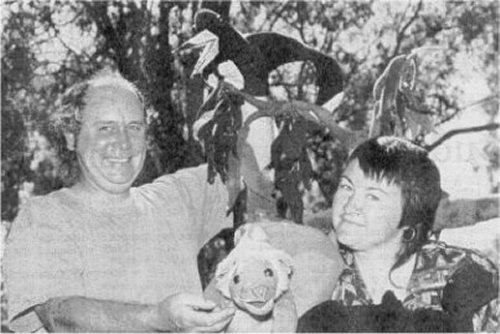
[Above] Economic refugees - PR for a new beginning, Roy & Julie McNeill Tivoli caravan park. (Photo courtesy of QLD Times, 1995)
I was anxiously awaiting an audience for Jika Jika Puppets from North Fitzroy, Melbourne. They were part of my Youth Arts program for the first Melbourne Fringe Festival that I was a founding member of, and hardly anybody had turned up!
Summoning courage I went up to the puppeteer, Roy McNeill, who was dressed in black clothes. He eased my feelings of incompetence by saying it was okay, because he was training a puppeteer into the show of The Four Chinese Brothers and they would look at it as a rehearsal.
A group of young unemployed performers and musicians who had hitched their way up the Nepean Highway from Frankston sat with me, cross-legged on the floor. We were enthralled by the Japanese style Bunraku rod puppets and the way they came to life. The sets were original, incorporating musical instruments within them, like the giant triangle used as a gong.
Committed to audience participation in all of his shows, Roy inducted us 17-25 year old young punks into the joy and wonder of our basic creative spirits: waving silks, making music and working puppets from the primary school show.
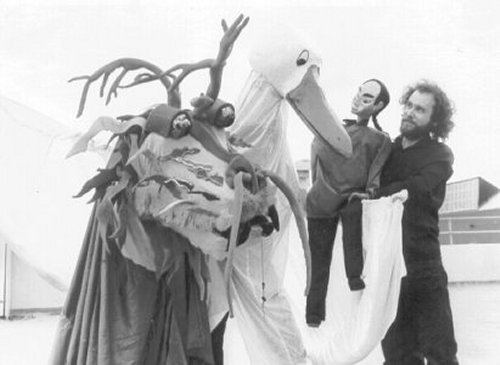
[Above] Jika Jika Puppets, Nth Fitzroy, Melbourne. (Photo courtesy of Sun Herald, 1981)
The Asian influences were breaking through to the arts and culture of Australia in 1982. Roy later explained to me when we met again at a Winter Solstice night feast in Brunswick Street a couple of months later, that his experience at Osaka for Expo '70 had changed his artistic vision and direction in life.
THE APPRENTICE
Roy trained as a puppeteer with the Marionette Theatre of Australia (M.T.A.), when he was seventeen. His father had read a Melbourne's Age newspaper classified for a young person interested in theatre and wanting to travel. Roy didn't know anything about theatre but he did want to get out of a grim future working as a salesman at McPhersons Hardware.
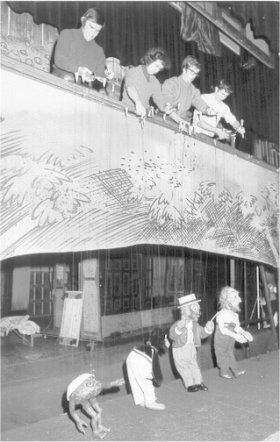
|
Amazingly, he passed the audition where he was asked to work a puppet and carve a pair of hands. He must have shown a natural talent, as well as being young and cheap ... There were not many women employed as they could not carry the large, heavy 'bridge', tracks and set. The one or two women there helped to set up the puppets.
"We had 3-5 tons of equipment. All the puppets were large, long string marionettes, whose heads were carved by sculptors from which negative moulds were made."
"The heads were then moulded with Silastic (a glue-impregnated material softened with acetone)," recalls Roy. "They were then covered with a skin made from pearl glue and whitening."
"These heads were very strong and light. The bodies were from half inch wood padded with flocking and canvas."
"Joining pieces like hips and waist joined with thick canvas webbing. Elbow and knee joints came from door hinges which had been loosened."
"The bridge from the ground was about 5 metres high. The puppeteers worked 3 metres up and controlled the puppets on the stage."
"There was a front stage and back stage with a scrim in between usually with a picture on it which one can see through when the lights were on the back, but appeared solid when the lights were on the front." |
[Above] Princess Theatre in Melbourne. (Photo by Archie McNeill, 1971)
The M.T.A. was part of the Elizabethan Theatre Trust. Under its umbrella were the first flagship companies of the Australian Ballet, Opera and Marionettes. It was a fateful connection because Roy was able to unleash a performance talent and develop into a multi-skilled puppeteer who gained confidence to write, design, build and manipulate puppets.
For a lad from Leeds who had arrived in Australia in 1964, this was a fabulous opportunity. The shows were accepted with applause around the country, but off-stage, life was risky. In the late 1960's life on the road was often lonely. Roy hadn't quite found his place socially; the rest of the guys were 'gay' but they looked straight with their suits and ties and short haircuts.
It was Roy who was the odd one out; proud of his long wavy hair and excited by the fashion of the flare and fancy ruffled shirts with costume jewelry, many a Queensland country town male accused him of being a 'poofta'. Not being tolerated, being beaten up regularly, caused an aversion to Queensland and Australia's limited tolerance of difference.
Fortunately a tour of SE Asia gave him a raison d'être to escape. He got to celebrate his 20th birthday in Osaka, Japan for Expo '70 with two shows, The Magic Pudding - a classic Australian story by Norman Lindsay and Tintookies 2000, a futuristic production that showed the evolution of humankind with lots of peace, love and harmony at the finale.
This production was innovative as for the first time it left the marionettes behind and the puppeteers worked a variety of styles of rod, glove and hand and mimed rod puppets "It didn't go down well in Australia as everybody wanted the cute little furry creatures on long strings."
The show was cut from the repertoire and never performed again. "It wasn't given a proper chance" says Roy.
However, the opportunity to discover a distinctly different culture and form of puppetry gave him the impetus to research the rest of the world's puppetry. He had saved his touring allowance by not eating in the hotels, and it wasn't long before he was on the 'hippie trail', going overland through Asia across to Europe.
Roy was disappointed. In Sri Lanka the artform was dead, and all of the puppets that he saw, though beautiful and interesting with the different controls, were kept in museums. Though puppetry was a living presence in India it was hard to find as, like the circus, the puppeteers moved from village to village and when he did hear that there were puppets, there was a war that prevented him finding them!
DOWN AND OUT IN LONDON
"On arrival in England I saw most of the puppet companies, as I am interested in the different styles of puppetry and was also looking for work", Roy wrote in a letter home to his mum and dad in Highett.
"I did not find any work as most puppet companies in Britain consist of a hard core of two or three puppeteers, and the rest of the company was made up of out-of-work actors, trying to gain hours on the stage to be able to join the Union, or middle-age matrons. Both groups were willing to work for a very minimal wage."
"I was not very interested by their type of puppetry. I don't really know if this was a reaction on my part because of not finding work but it all seemed so trivial and removed from reality (possibly this is what they wished to achieve). They all were beautifully-carved wooden dolls."
"I reacted against it as I wanted something more spontaneous and stimulating, something which was not totally removed from reality but an extension of it. Wood was no longer as easily obtainable as it was 200 years ago. I settled for plastic and cardboard. I must say here the choice of materials was partly due to my own economic conditions." (Finnsbury Park,U.K. 1972)
One puppet company was explicit about the industry, telling Roy that if he wanted to be a puppeteer in England, he'd have to go and get a job in Yorkshire. In other words just as the ABC only had BBC spoken presenters, back in 'the homeland', regional accents were a form of class distinction.
Roy got a job as a postman to save money to go back to Australia. Even with alternate 8 and 16 hour shifts, with youthful energy and optimism, he wrote his own puppet script, The Dragons Secret Treasure, and designed puppets made with plastic bottles, egg boxes and fabrics. These early designs would become the foundation of his commitment to taking the art of puppetry into schools with his own puppet company.
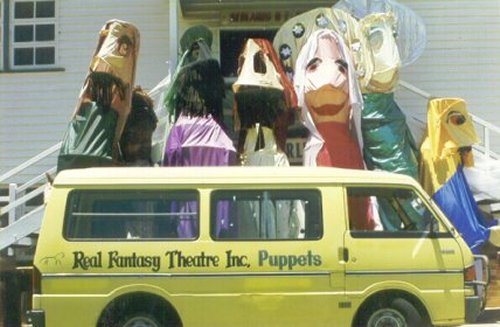
[Above] 5 metre Nativity parade puppets to be lit up at night - Redlands Shire, Brisbane. (Photo by Julie McNeill, 1995)
RETURN
The Pilgrim Puppet Theatre was an old Church in Hawthorn that was run by Robert and Nancy Aitkins. It had a great puppet set-up with a stage that moved across, backwards and forwards to change sets easily, just like the Japanese Kabuki stage.
It was the best-equipped puppet theatre but, like many theatre companies, the issue of survival was a constant pressure. There were school shows during the week, but the first petrol crisis was occurring and it cost more to bus the audience in than the cost of the show.
To cut the cost of using professional actors for the pre-recorded voices, the puppeteers decided to design a more stylized, simpler puppet show using a combination of marionette and rod puppets, and used their own voices. Roy was involved in designing, making and writing the scripts. The puppeteers negotiated to get paid four days a week and the use of the theatre and equipment on weekends for experimenting with the artform: sheets of cardboard made into breathing triangles with soundtracks and other objects reacting with each other. Then Roy wrote his first Nativity - A King is Born.
"It had to be very reverential - no funny bits, but it was still a hit and Robert praised the Lord! Unfortunately he didn't praise the puppeteers for their almighty effort."
It was announced that this success was a sign from God that they were to do more religious-themed shows so half the puppeteers left. Roy stayed for David and Goliath but the atmosphere was too nineteenth century to linger.
Roy left Pilgrim Puppets with $600.00 saved and he had a choice to start up his own puppet company or go on a cruise to New Guinea. As it also coincided with the breakdown of his five year marriage, Roy was ready for a sailing adventure or, as it turned out to be, near death experiences! He would return to Melbourne with a profound respect for solid ground, and moved into a shared house in Fairfield, taking over the garage to build puppets and sets for the shows he'd always wanted to produce.
In the mid-1970's the Melbourne arts scene was flourishing with optimistic, experimental and socially conscious young people. Some were fresh out of Arts and teaching courses, some like Roy were un-schooled, self-taught scholars with a working-class wit (the teachers hadn't been able to knock the stuffing out of him) - perfect for puppetry.
Enthusiasm for the potential of contemporary, exploratory puppetry, connections and alliances were made with people of similar ideas and intentions. Roy freelanced around town with newly-formed companies like Handspan, Kooka Puppets and B'Spell Performance Troupe, until in 1980 at the age of 30 years he launched JIKA JIKA PUPPETS.
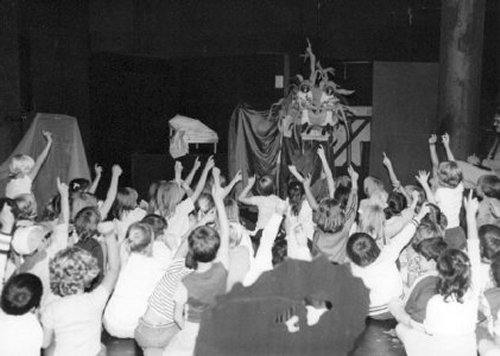
[Above] Who wants to get inside the Chinese Dragon? Theatre-In-Schools program. (Photo by photographer unknown, 1981)
Towards the intersection
Meanwhile, on the other side of the city, I was aged 18yrs and no longer captive to the new suburb of Clayton, where my family had emigrated in 1978. My alcoholic mother and step-father shared no respect for the Shakespeare I was reading, or the history of Asia I was absorbed in, so I looked in her Year. 11 Legal Studies book to see when I could leave home without getting in trouble.
Safely sixteen, and resourceful, I lived in spare rooms, shedding poetry about the waves of my emotions. I was initiated into Emile Zola, Tolkien and Camus by my friendly, pot smoking, fresh faced college graduate teachers, who supported my path to individualism. I performed centre stage in sixth form plays, and was encouraged to pursue a life in the arts.
There was purpose in writing for Hard Times, a free newspaper I picked up in a Sandringham Op-shop, because I had stories to tell about being on the Under18 dole of $36.00 a week. Jobs were elusive. I didn't have the right clothes or the train and bus fares. My energy was leaching out of me, until I couldn't get out of the bed I was renting in an old lady's back garden shed.
Co-incidentally, all at once, a job in Abbotsford, close to the city, came from a perceptive accountant who appreciated a well-written letter, and was amused by my quirky dress and pixie boots. A surprise visit from a friend of a friend who needed a new flat mate in Elwood and I was whisked away to roads with tram lines and the delights of Acland St.
There was a vibe in the village, a multi-cultural openness, along with an appreciation of enticing cakes and cafes with delectable soups and decent coffee. All around the walls and the windows, there were art and posters to read and be persuaded to be an audience to - admission by donation. I picked Seven, a collaborative, experimental performance from an ensemble of ex-Rusden student friends.

|
Mesmerised and delighted by the movement and the courage of it, the Director invited us to an inaugural meeting to set up a network of fringe artists. It was enough to catapult me out of my employment blues.
I had already been enrolling in acting classes all over town, some more mainstream, others more challenging and playful with text. I had also moved to an art deco style block of flats where resided an intimate community of friends pre - The Secret Life of Us.
Unlike in that TV series with its tertiary educated, childless individuals, most were misfits of Catholic working-class suburban ordinariness. They were artistic and had babies who they had to hold tight to against pressure from the nuns. I had found a haven of compassion and understanding and was inspired by their courage and imagination to transcend conventions that were impossible for our creative spirits. |
[Above] Roy McNeill with Bunyip Blue Gum, SE Asia tour, Marionette Theatre of Australia. (Photo by photographer unknown, 1970)
Significantly we all shared a knowledge of how to live an artistic life very cheaply. They nurtured me, in my uncertainty, handing me brushes to experiment with paint, initiating me into the magic of the Pre-Raphelites and Picasso, Matisse and Bolero. They brought my attention to the wonders and details of Nature that I hadn't had since primary school. I was a novice, learning how to be a woman under a spiritual eclecticism of the gods, goddesses and Tarot cards.
In my flat, elevated by Hoist's - The Planets and Dexy's Midnight Runners I wrote poetry as one long performance piece. I was unaware that I was expressing all the fears and hopes I had, and the occasional psychotic hallucinations, which I know now were the signs of my struggling with the lows of depression and the ecstasy and thrill of life in hypomania. Nobody talked about mental illness then, but through good friendships, fun and art I stayed sane enough to work on the other side of town.
Fringe Network, a coalition of non-mainstream artists, established itself in the old Flying Trapeze Café in Brunswick St. Fitzroy. I happened to be younger, less educated and probably most naïve. Stirred by the artistic intensity and community activism I put my hand up to represent Youth Arts. At that time there was no Next Wave in Melbourne. Only South Australia had a dedicated interest in the cause of promoting young people who were keen to be mentored in all the art forms via the state sponsored Come Out Festival. I had a cause and flew with it.
Funding was received from employment and training initiatives like the Commonwealth Employment Scheme, which enabled many community projects to pay wages to their volunteers and receive training in administrative skills. The first Melbourne Fringe Arts Festival 1984 was the pivotal event of my new life.
Meeting Thom the Street Poet at the first celebration of Fringe Network in City Square meant I was invited to perform my poetry at the friendly writers' venues like the Living Room run by Anita Sinclair, who also had a passion for masks and puppetry.
Life-long friendships were made during this festive time, and it wasn't hard to find a lover ... I wasn't looking for a husband, but when I saw Roy the Jika Jika Puppeteer walk in to the Winter Solstice party in the building above the Black Cat Café, I was drawn to his side. I reminded him that we had met before, and he remembered that he hadn't been paid! I've been working for him ever since!
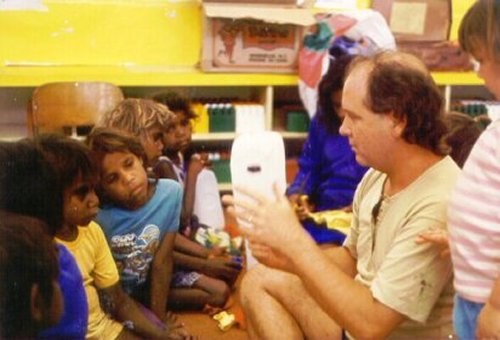
[Above] Roy and students of Lajamanu Primary School (Tanamai Desert, N.T.) learning how to turn rubbish picked up from around the streets into puppets. (Photo by Julie McNeill, 1989)
A PUPPETEER BY DEFAULT
Within two weeks of a whirlwind romance, where I was introduced to Roy's culinary arts and the preparations of the premiere of his latest puppet production, we decided to live together. Going backwards and forwards down Hoddle St was time wasted when you didn't want to be apart ... plus the set of The Adventures of Platypus Phil which graced the whole of the lounge-room, and most of the rest of the North Fitzroy terrace house, wouldn't have fitted in my flat.
At that time Roy employed a part-time administrator to get bookings and two other puppeteers who helped to make the puppets and perform the shows. Roy was so inspired by my Rubinesque physique, that he sculpted Mt. Higginsbottom out of dyed foam rubber as part of the rural setting, where the thorny devils hung out. So uniquely Romantic!
The tale of a platypus who was curious about the world outside of her burrow and ends up on South Melbourne beach after a big storm was topical in its expression of children's rights and the wonders of our flora and fauna. Then one morning I was woken early by news that one of the puppeteers hadn't turned up and they had a show to do in two hours!
I had seen the rehearsals and the shows they said ... all I had to do was do the Rock Wallaby part and they would be able to cover the rest! Within ten minutes I was in the van travelling to my first gig, learning my lines up the Calder Highway!"
THE ADVENTURE BEGINS
"Like any adventure" says Queen Snooze to the children, "it is exciting but also a little bit scary, but there's no sense ruminating, we must set off!" Roy rehearsed me into THE DREAM GOBBLER - an enchanting tale with a medieval style about Princess Lullabye who is having bad dreams. A variety of hand, rod and body puppets were used with a north/south/east/west set so that the Royal pair would take their puppet horse through the audience and be led to different countries where they might find a cure for bad dreams.
Jika Jika Puppets continued its hand-to-mouth theatre-in-education schedule but was knocked back from the Australia Council and Victorian Ministry for the Arts for project funding for the adult puppet show script and designs of Kitchen Sink.
"We were performing Dream Gobbler and Four Chinese Brothers, rehearsing Platypus Phil, so we hired a student dramaturg from Victorian College of the Arts to work on the application forms. The task was to take the strengths and weaknesses of all the different kinds of puppets and give them a character.
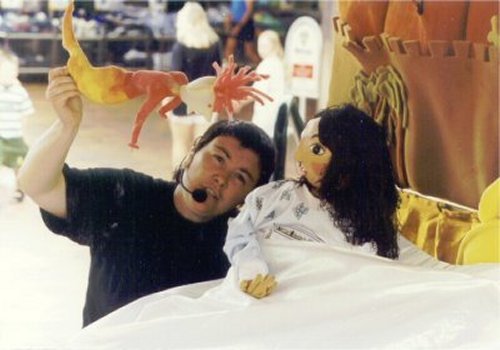
[Above] Julie McNeill in Ipswich Mall performing THE DREAM GOBBLER as a one woman show during the school holidays in January. (Photo courtesy of QLD Times, 2002)
The strongest was the Mother who was a body puppet, and the Father was a rod puppet whose movements were mechanical so he was a process worker. The Son was impressionable so he was a marionette blackboard boy. The impetus came from the slap around, slap stick of the Punch and Judy tradition and the social realism of theatre that had been revolutionary in Britain, so I wanted to do the same with puppetry, but once there was no funding for it, the puppeteers slowly started to leave.
They'd given their all with the shows, plus the company was financially unsustainable. Mailing out 3000 flyers only got a one percent return. On a good week they would get a hundred dollars.
Roy had always wanted to have children and he had proposed kids, not marriage, in the first fortnight before moving in. He explained to me that he couldn't wait around as he was thirty-three. In 1984 we married in the Edinburgh Gardens (a rare thing in the artistic community then)!
Domestic issues came to the fore. Overcome by the experience of pregnancy and child-birth I wrote my poetry play RITES OF PASSAGE while breastfeeding. Parts of the production used slides and shadow puppetry to dramatise the conflicts of my ruined relationship with my parents.
I performed the show at La Mama for the first Next Wave festival, Universal 2 for the Fringe and also the Women's 150 festival. It was well received and I produced a cassette of the show.
It was also hard to keep performing with Roy in The Dream Gobbler. Half-way during the show my breasts would be so hard! By the time Queen Snooze had shared her magic cakes and was laying next to the children to have a snooze, ready for the witch to appear, milk was seeping out of my costume!"
Thinking of our priorities, we got a loan for low-income earners from the State Government and moved to a solid home and garden in the child-friendly town of Kyneton. Roy took over the middle room to build a new show, THE QUEEN BEE.
It was a perfect show for primary school students as it was made completely out of rubbish: cardboard boxes, tubes, plastic containers and material. Roy was showing them how they could make great puppets with everyday things. He had been reading The Uses of Enchantment by Bruno Bettleheim too, clarifying the importance of fairy tales to our lives and so our creative partnership became REAL FANTASY THEATRE.
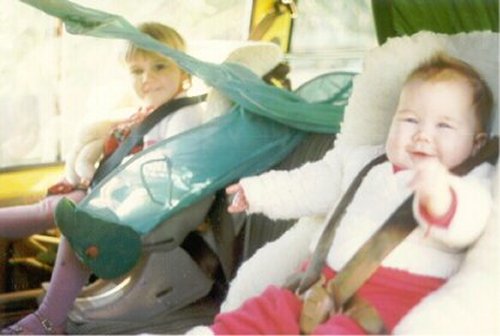
[Above] Our daughters ready to go on their first school tour in NSW.
(Photo by Roy McNeill, 1987)
PUPPETS AS ENDANGERED SPECIES
It was during this time that somebody in the audience had appreciated the joy and wonder of the other show called LET'S NOT SAY GOODBYE - about endangered species. After years of packing out tons of heavy wooden puppets and sets Roy had worked away, making his puppets light and transportable. Foam rubber was a perfect material. It could be dyed an array of bright colours, was easy to sculpt and glue with contact adhesive and it gave the puppets an ease of life-like movement.
Centre stage was a tree set over an aluminum step ladder. A branch represented every continent and that housed the different puppet characters who all had their own humorous voices and sad but true tales. The vast variety of animals represented Roy's passion for Nature and his concerns for their future, but I also was certain that they portrayed all the different aspects of his personality!
There was the tapir and toucan, the bush baby and python, wooly monkey and sloth, a rhino who loved to sit in the bog and dream, and Possum Gaddafi who was threatening to rap-dance in peoples ceilings. The European rat who was hitching a ride to Australia said his hair was green due to acid rain.
Fortunately there were visionary public servants in Victoria at this time who were inspired by Roy's ability to pass on an environmental message to a large, diverse audience in such a comically visual way. The recycling unit of the Environment Protection Authority commissioned a play and it was called MANY HAPPY RETURNS.
Scraps, a hungry backyard duck is scavenges for wrigglers.
"Just as he is hedonistic, amiable, funny and a little nerdy, each individual component of the piles of rubbish has its own peculiar personality and delivery. There is the rhyming compost heap, a pile of bottles eagerly awaiting their friendly bottle-o and their consequent transformation; the soft drink and baked bean cans who are to seal their various friendships by being crushed together and lastly the stack of papers as big as a tree who are also keenly anticipating their next re-incarnation." (Wendy Boynton, Lowdown, Feb, 1993).
Although I was unable to perform in the shows with two toddlers needing most of my attention, the family toured schools around Victoria, South Australia and New South Wales in our trusty yellow Mazda 1800 van.
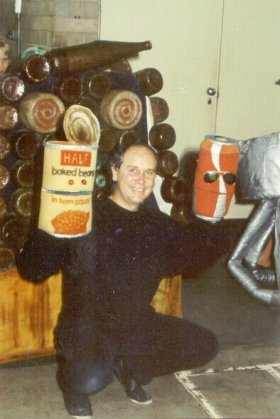
|
Loaded up with dog, kids, and nappy buckets and camper-trailer it was a working holiday of which the highlight was a Northern Territory tour that included a two week residency in the Aboriginal community of Lajamanu.
The Energy Information Centre also applauded the innovative way of using funds by commissioning a show on the issue of energy conservation: IT'S UP TO YOU. Although a seemingly difficult concept to put into an entertaining play with puppets, Roy's ability to transform representations of everyday objects into startling characterisations solidified his unique capacity to inform with content, art and fun.
By 1994 this trilogy of curriculum-based puppet shows was failing to lure teachers in a climate of Kennett-led job pay-outs and school closures. It was an icy wind in Kyneton too, so the family decided to audition the recycling show for the Queensland Arts Council.
There was hope that under Labor's Goss government the censorship of the Joh Bjelke-Peterson days was on its way out. MANY HAPPY RETURNS was allowed to enter Queensland primary schools but only if the two soft-drink cans, Sticky and Sweet, were not so full of double entendre.
|
[Above] Roy in Weipa, making sure those soft drink cans don't get too close for the Qld Arts Council! (Photo by photographer unknown, 1990)
This meant, when Sweet tries to cheer her can-pal up about being recycled by saying: Just think, if we are to be crushed so tightly together we will become as one….or two or a whole stack of little cans! AND SHE SHOVES HIS SUN GLASSES ASIDE AND YELLS: Ah come on, just take off those sunnies or I'll crush them! AND KISSES HIM the Queensland Arts Council wanted to tone down that whole scene…
AN UNCERTAIN LIVELIHOOD
As the children got in the higher grades it was becoming problematic to go on the longer tours, so Roy would go by himself which he didn't like. He would even drive back a 1000kms after two or three shows on a Friday, just to be home at the weekend.
Three months in Northern Queensland and the Torres Strait was a fantastic experience and good money but the light plane only fitted the puppets, the puppeteer and pilot. It was too lonely and Roy decided he'd never ever want to be away from the family for so long again.
After thirty years as a professional puppeteer one can be called a Master, but a Master Puppeteer also delivered diagnosis of osteo-arthritis, and the realisation that there was no accumulated superannuation. Living expenses were increasing and less work was coming in, meaning more time dealing with social security and having to apply for jobs in which he had no experience and was too old for.
Regional isolation had meant being out of the loop for opportunities with colleagues and new projects, so being squeezed into a supporting puppetry role for a children's television series called Lift Off was a dent in Roy's sliding self-esteem, even though the pay was great.
An agent had engaged Roy to take a puppetry film to country schools and then run 'rubbish' puppet-making workshops. A book proposal for a How to series published by Angus & Robertson fizzled out due to the series being abandoned. He went back to Kitchen Sink, offering the play to funded companies, but they had their own agendas. Even applications to be Artistic Director in companies he had connections to were rejected, especially galling when non-puppetry people were appointed instead. I encouraged Roy to spend the time creating a new adult show which he had been dreaming about, based on the surrealism of Max Ernst.
The interpretation was not to the painter's trustees liking, and they rejected it strongly. Having the same difficulty as Roy finding regular work, I learned to drive and put together a one woman show for pre-school audiences called THE GINGERBREAD KID. Roy made the puppets and sets and I set off doing shows but it was still not enough.
After 30 years of professional experience and evolving artistry Roy couldn't get a different job or find a way to pursue his ambitions in the puppetry world. His last application for support was at the new Melbourne Museum to be an Artist in Residence - bringing the arts and sciences together in an imaginative, accessible way - but he was pipped at the post by an academic who was writing a dictionary on the language of Antarctica.
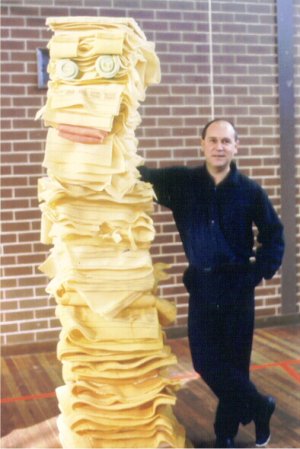
|
The State we left behind,
Had no use for us,
So stagnant had our life become,
Our visions meaning nothing, and
So we picnicked in that gutted Albert park to fare-well
Friends, surrounded by yellow flickering ribbons for
A car race, then up the Calder we drove
Away from the rows of daffodils.
For us, a tropical, new labour dream as
The ties on the trailer tarpaulin flapped
Showing glimpses of old shows, bits of plywood
And foam scraps for new puppets;
Trash to other eyes so no fear of theft, them
Polystyrene balls, bags of fabric, tubes, beads and
Tins of glue, all seeds of fortune for us
Poor transient artists riding up the Newell.
The only hope for the future was to sell up and start again. The Queensland Marionette Theatre was winding up and there was a good chance, said the project officer for Arts Queensland, that REAL FANTASY THEATRE would do well there, especially with their latest black theatre script, REEF. It was promising. |
[Above] Roy with the paper stack puppet whose dreamtime is in the forest and is now to become mulch for new trees. MANY HAPPY RETURNS was a a puppet show about recycling - performed in schools in Victoria, New South Wales, Northern Territory, Queensland and South Australia 1988-1998. (Photo by Archie McNeill, 1987)
Brisbane City Council aided promotion of the recycling show, but the chief at Queensland Arts Council didn't want Roy back, though he might look at a new show. We suggested that a couple of tours would bring money to create a new show, that we had had consistently good feedback from students and staff, but we were not what he wanted. It was made clear that we wouldn't be able to go into Queensland schools without their authorisation.
I networked from the Tivoli caravan park, building up clients and re-working THE DREAM GOBBLER for parties and fetes. When the stormy season hit, the black light theatre application for THE REEF project was rejected. However the family had found a home on a hectare of land. With somewhere safe and private to settle, I let the tears and agony of a major depression flow.
It slowly dawned that puppetry had no future without recognition and funding, especially for the projects that we wanted to deliver for our souls to grow. Roy was burned out from years of producing quality, uniquely Australian puppetry, contributing to a dynamic culture.
The priority was our daughters. Thriving on the love and creativity of our parents wasn't enough in the teenage years; new sneakers and clothes, orthodontist treatment and money for a decent education were what were needed.
Driven to wear suits and shiny shoes
We presented ourselves to a myriad of
Arts administrators at many meetings in
Designer furnished towers and
Civic buildings to bid for a share of
Creative Nation with our puppets,
Poems, Plays and possibilities of
Producing to thrive 'stead of
Merely survive.
THE MAGIC OF PUPPETRY
Puppeteering is an imporrant part of creatIve culture in AustraLia that needs to be nurtured and supported more than it already is. Sharing the joy and wonder of learning through the artform of puppetry to young and older is unique. A puppet enters - the audience laughs, it moves, it speaks - laughter and excitement.
The content of the message is absorbed on many levels. Teachers and children have witnessed miracles as previously 'shy' or 'troublesome' kids participate in the shows when invited by Roy to work a puppet.
In towns like Moree, with a sorry history between black and white populations, the astonished reaction to an indigenous girl being picked to play the part of a princess was an indication of how the arts can transcend race and cultural barriers.
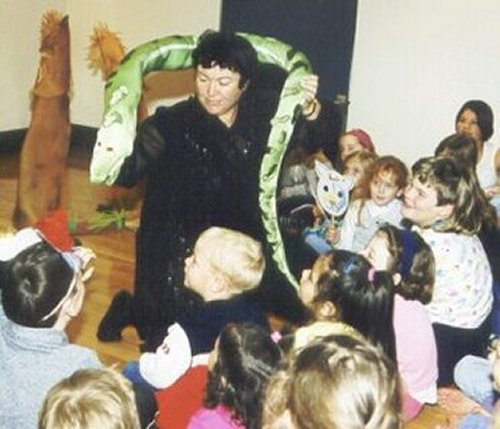
[Above] Julie McNeill with carpet python(tawny frog mouths in background) from Little Red Cap puppet show at Ipswich Art Gallery. (Photo by Ipswich Art Gallery staff, 2003)
The magic of puppetry is that the discipline and skills of the puppeteer is translated as anarchic, a life force of its own making. Even the Christians used puppets as props for their biblical stories as have Shamans for their proselytising. The puppets are okay when they use it, but not when a free running puppet gets loose! For some young boys who find it hard to contain or communicate their feelings, their natural inclination is to hit and pull when all they really want to do is to cuddle the cheeky puppet!
Rather than punish, aggression is channelled into creative and respectful behaviour. The puppet promises that if they sit quietly on their bottoms, they can shake the rock-wallabys foam paw, or if they stand up and are kind and gentle, the python will wrap itself around them and give them a big hug!
Our discipline becomes theirs as they learn to interract with the puppets gently whilst still having the fun of spontaneity.
As a reward for being a great audience they are invited to ask questions about the puppets and sets. Then they get to work a puppet and join in with Roy as he leads them through an improvised performance, revising the themes of the show.
The response of adults is as joyful. Their child within comes forth and they cherish the experience. Laughter is freeing. It is wild and silly. A class of Year 7,8 & 9 private school girls turned to look at a teacher to see if she was laughing. Was it proper to laugh at the crazy duck antics? Scraps the duck was so uncool he was hilarious. There's a lesson in that too.
A 'REAL' JOB
We laughed when Roy got a job as a carer for Disability Services, as the ongoing family joke from his Uncle Jesse was: "Hey lad, have you got a real job yet?" At forty, Roy could lift the fog of his mother's dementia by telling her how much he was earning on a regular wage, plus shift allowance and superannuation.
For the first time in our lives we had a secure income, which our daughters both appreciated, declaring that there was no way they were going to pursue a career in the arts!
Occasionally we do a puppet show and workshop, but these are rare events. I utilise my creativity and experience within the Diversional Therapy field. Roy's passion for the artform has transformed into planting native rainforest trees and other indigenous plants, plus looking forward to a well-deserved long-service leave!
About the Writer Julie McNeill
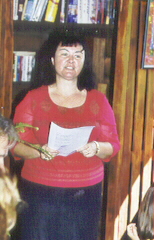
|
Julie McNeill arrived in Melbourne in 1978 and wrote her first poems. Homeless at 16, she managed to get through Year 12 to the U18 dole. Julie wrote her first journalistic articles for 'Hard Times" newspaper for the Unemployed. She learned book-keeping for a year before getting depressed and moving to St.Kilda, where she discovered painting and writing for poetry performance. She is a founding member of 'Fringe Network', a resource for artists and Youth Arts Co-ordinator for 'Melbourne Fringe Arts Festival'. She met lots of life-long, loving poet friends at various reading venues and has performed multi-media 'Rites of Passage' 1985 in Melbourne theatres, inspired by the births of two daughters. Julie was trained by her husband Roy as a puppeteer, performing in schools and community venues throughout Australia for the next 20 years. She continues to write poetry, prose & journalism for www.brisbanevalley.info in Queensland. Julie has recently used her creative skills and intelligence in work as a Diversional Therapist in disability services and aged care. |
[Above] Photo of Julie McNeill by Roy McNeill, 2003.
I Next I
Back I
Exit I
Thylazine No.11 (June, 2006) | 


